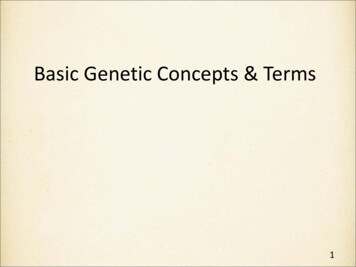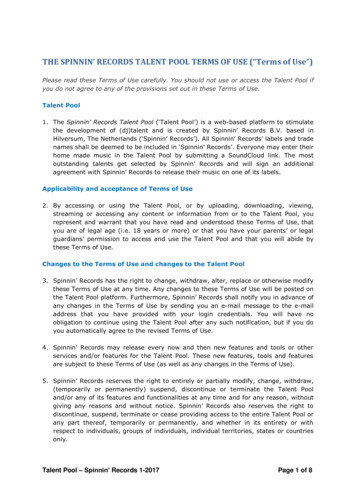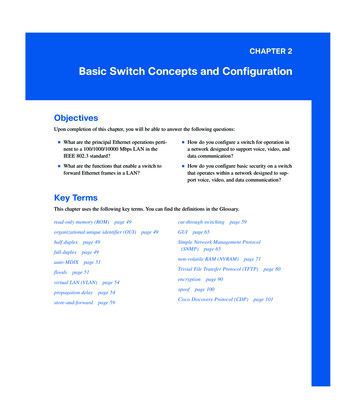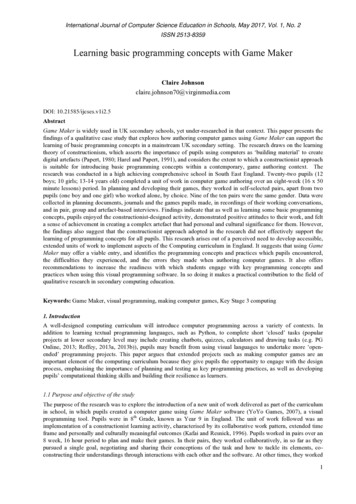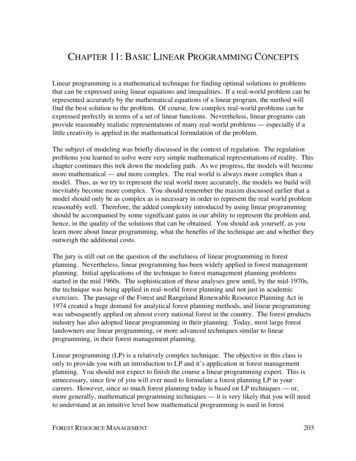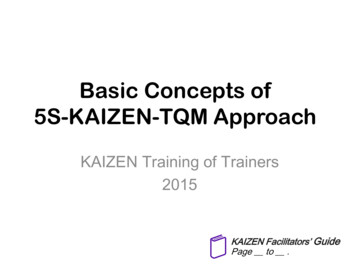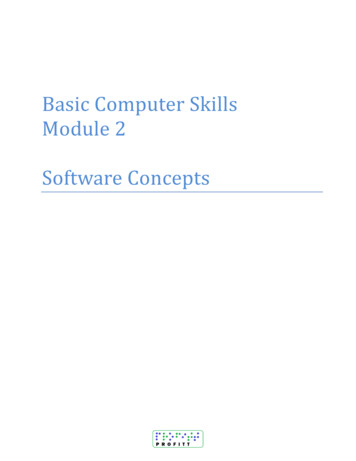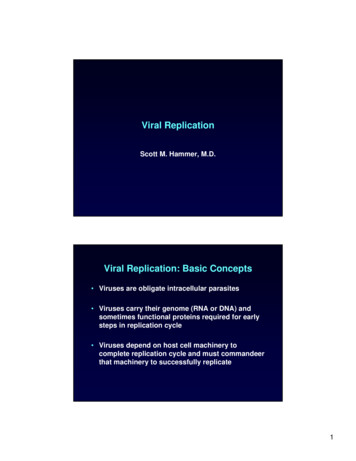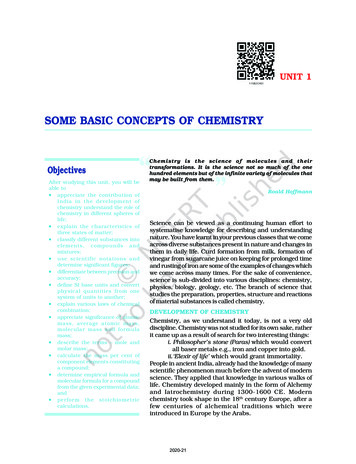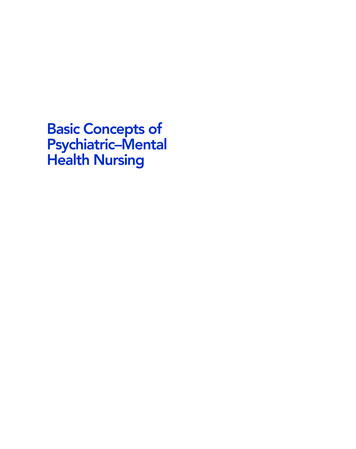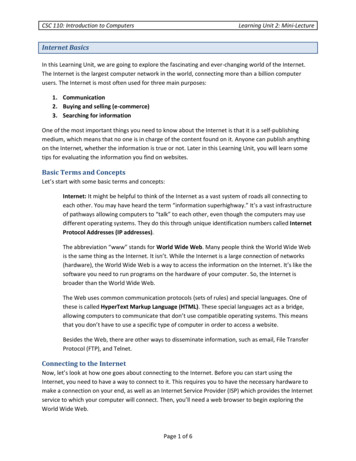
Transcription
CSC 110: Introduction to ComputersLearning Unit 2: Mini-LectureInternet BasicsIn this Learning Unit, we are going to explore the fascinating and ever-changing world of the Internet.The Internet is the largest computer network in the world, connecting more than a billion computerusers. The Internet is most often used for three main purposes:1. Communication2. Buying and selling (e-commerce)3. Searching for informationOne of the most important things you need to know about the Internet is that it is a self-publishingmedium, which means that no one is in charge of the content found on it. Anyone can publish anythingon the Internet, whether the information is true or not. Later in this Learning Unit, you will learn sometips for evaluating the information you find on websites.Basic Terms and ConceptsLet’s start with some basic terms and concepts:Internet: It might be helpful to think of the Internet as a vast system of roads all connecting toeach other. You may have heard the term “information superhighway.” It’s a vast infrastructureof pathways allowing computers to “talk” to each other, even though the computers may usedifferent operating systems. They do this through unique identification numbers called InternetProtocol Addresses (IP addresses).The abbreviation “www” stands for World Wide Web. Many people think the World Wide Webis the same thing as the Internet. It isn’t. While the Internet is a large connection of networks(hardware), the World Wide Web is a way to access the information on the Internet. It’s like thesoftware you need to run programs on the hardware of your computer. So, the Internet isbroader than the World Wide Web.The Web uses common communication protocols (sets of rules) and special languages. One ofthese is called HyperText Markup Language (HTML). These special languages act as a bridge,allowing computers to communicate that don’t use compatible operating systems. This meansthat you don’t have to use a specific type of computer in order to access a website.Besides the Web, there are other ways to disseminate information, such as email, File TransferProtocol (FTP), and Telnet.Connecting to the InternetNow, let’s look at how one goes about connecting to the Internet. Before you can start using theInternet, you need to have a way to connect to it. This requires you to have the necessary hardware tomake a connection on your end, as well as an Internet Service Provider (ISP) which provides the Internetservice to which your computer will connect. Then, you’ll need a web browser to begin exploring theWorld Wide Web.Page 1 of 6
CSC 110: Introduction to ComputersLearning Unit 2: Mini-LectureInternet Connection Methods1. Dial-up: Dial-up is a method that uses a telephone line, which you connect to a phone jack, justas you would connect your telephone to the wall. Dial-up is the slowest connection method andit requires your computer to have a dial-up modem.2. Broadband: Broadband is a high-speed connection method which can utilize cable, DSL, orsatellite. Each of these methods requires different types of hardware.3. Fiber-optic: Fiber-optic communication transmits data by sending pulses of light through ultrathin optical fiber. Because light travels so quickly, this technology can transmit Internet data atsuper-fast speeds.Internet Service Provider (ISP): Internet Service Providers are companies that connect you to theInternet – for a fee, of course. ISPs are available on a local, state, and national level. Largecommunication companies control access to the main lines of the Internet structure. They, in turn,supply Internet access to the smaller ISPs, who pass this along to the consumer. Not all ISPs offer allmethods of connection to the Internet. Make sure the ISP you select offers service that corresponds toyour connection method and hardware.Web Browser: You’ll need to have a web browser installed on your computer. This is a softwareprogram that allows you to view web pages and navigate the Internet. Microsoft’s Internet Explorer isprobably the most commonly used web browser. It often comes pre-installed when you purchase acomputer that has a Microsoft Windows operating system. There are other free web browsers available,including Mozilla’s very popular Firefox web browser and Apple’s Safari. You can have more than onebrowser installed on your computer.In summary, you need three basic things to connect to the Internet:1. A connection method2. An Internet Service Provider (ISP)3. A web browserSurfing the Web“Surfing the Web” or “Web Surfing” refers to browsing the World Wide Web by going from website towebsite in search of something that interests you. Before we talk about how to surf the web, it may behelpful to explain a few key terms. Take note of how they are spelled and used.A web page is a single page of information on the World Wide Web.A website refers to a group of web pages identified by a single domain. For example, all of the webpages on the Indian Hills website begin with “www.indianhills.edu.”A homepage is the first or front page of a website. If you were to type “www.indianhills.edu” into yourweb browser, the first web page that came up would be the website’s homepage.For example: The Indian Hills website contains many web pages, including the homepage.Page 2 of 6
CSC 110: Introduction to ComputersLearning Unit 2: Mini-LectureA URL or “Uniform Resource Locator” is the unique address of each web page. For example, the URL forthe Indian Hills Bookstore is: h URL has several parts that appear in a specific order. Let’s look at each part by using the URL forthe Indian Hills Bookstore as an .htmlProtocol: A protocol is a set of rules, used to retrieve a specific document. The “http” in our URLrefers to HyperText Transfer Protocol. The “http” is followed by a colon and two forwardslashes, then “www,” which refers to the World Wide Web.Domain Name: The domain name consists of two parts. In our example, “indianhills.edu” is thedomain name. where “indianhills” is the host and “.edu” is the top-level domain. This suffixindicates the type of organization to which the host belongs. As you can probably guess, “.edu”indicates that the host, “indianhills,” is an educational institution.Common Top-Level Domains.com Commercial or business websites, however anyone may use this now.govUnited States Government websites.milUnited States Military websites.orgOrganizational websites (often non-profit organizations)Directory/Page: The next part of the URL tells the web browser where to find the specific webpage on the website. In our example, the “/bookstore/” tells us that the web page we arelooking for lives in the directory/folder entitled “bookstore.” The next part, “index.html,” is thename of the actual web page. The “.html” refers to the programming language used to createthe page (in this case, HyperText Markup Language or HTML).Knowing the URL of a web page is the fastest way to find the page you want to visit. Just type the URLinto the address bar of your web browser, hit the Enter key, and you’re off to that web page. However, ifyou don’t know the URL, there are two other popular tools that can help you find the information youneed.A Search Engine is a website that searches the World Wide Web for specific keywords, which you enterinto a search field. The search engine then displays a list of web pages that are somehow related to thekeywords you entered. You can then click the links to any of these web pages that interest you. Searchresults are not perfect. You may be looking for a specific website that does not appear right away. Mostsearch engines have advanced options that allow you to narrow your search. For example, you maywant to find information about jaguars (the animal not the automobile). If so, you could use theadvanced features of your chosen search engine to exclude search results that include the words “car”and “automobile.” Each search engine does this differently. So, you will have to explore the website ofyour selected search engine for more.Page 3 of 6
CSC 110: Introduction to ComputersLearning Unit 2: Mini-LectureGoogle (www.google.com) and Yahoo! (www.yahoo.com) are two popular search engines.A Subject Directory is a listing of websites organized by topic. As mentioned earlier, not every web pagethat comes up in your search results may have the most relevant or the most reliable informationrelated to your topic. Subject directories are usually more selective in what they include than are searchengines. To use a subject directory, select a main subject from the directory, which then displayssubdirectories or folders. Continue to drill down, narrowing your topic, until you find a web page thatinterests you. Some search engines include subject directories in their list of features and someacademic and professional websites include subject directories related to their specific areas of interest.In summary, there are three basic ways to begin to surf the web:1. Enter the URL of a website you want to visit2. Use a Search Engine3. Find your topic in a Subject DirectoryInternet CommunicationEmail is an extremely popular means of communication. In fact, it has become so integrated with theflow of our work and personal lives that it may be difficult to remember a time when we could notcommunicate this way. However, there are also many other ways to communicate via the Internet.We’re going to describe some of them, now, but we encourage you to find out more about each ofthese options on your own and consider how they might be useful to you.Instant Messaging (IM) and Chat Rooms: These tools allow you to communicate with otherswho are online at the same time as you. The key difference between this and email is that withemail there is a delay, as you wait for the other person to receive the email, read it, and reply,whenever they are next online, while with Instant Messaging or Chat Rooms, all participants areonline at the same time, interacting “live.Podcasts: Podcasts are audio or video recordings available for download from the Internet. TVshows, newscasts, and instructor lectures are some examples of content that can be deliveredvia a podcast. While some audio and video recordings are streamed over the Internet, meaningyou watch them in your web browser, podcasts are different in that they are downloaded foroffline listening or viewing. Podcasts can also be subscribed to via RSS feeds. An RSS feed allowsyour computer to automatically download a new podcast whenever it is created, without yourhaving to visit its website directly.Blogs: A blog (short for “web log”) is a public journal posted on the Internet. The word blog canbe used as both a noun and a verb. You may have a personal blog or you may blog about yourcareer field. People blog about a wide variety of topics. If you have a hobby or topic which youenjoy, you can probably find any number of blogs related to the subject. One distinguishingcharacteristic of blogs is that they usually allow readers to post comments responding to theoriginal blogger’s post. In this way, large interactive communities can develop around popularblogs.Page 4 of 6
CSC 110: Introduction to ComputersLearning Unit 2: Mini-LectureSocial Networking: Social networking sites, such as Facebook, LinkedIn, Twitter, Flickr, andYouTube are convenient ways to meet new people, share photos and videos, connect withfriends, and more. These are typically easy to use and include free services.Voice over Internet Protocol (“Voice over IP” or “VoIP”): This is a voice-based Internetcommunication solution that uses a standard Internet connection to place phone calls. Skype isan example of a software program that allows you to place calls over the Internet. Skype userscan call one another over the Internet for free, while calls from Skype to traditional landlinephones may be made for a fee.Tips For a Better Internet ExperienceWhile there are great benefits to using the Internet, there are also downsides of which you should beaware that range from simple annoyances to serious risks.Spam refers to unsolicited, junk email. If you use your email at all, chances are good that your emailaddress will eventually be discovered by spammers (those who send junk email) and be added to theirmailing lists. The good news is there are some ways you can minimize spam.1. Create a free webmail account. Webmail or “web email” refers to an email account accessedthrough a website. Keep this secondary webmail account separate from your primary emailaccount and have it forward to your primary account. Use this secondary webmail accountwhenever you fill out forms on the web or perform similar tasks, rather than your primary emailaccount. If the webmail account gets overwhelmed with spam, you can always create anotherone and delete the old one. Just be sure to update your email address on any importantwebsites you use, before you delete the old one. Gmail, Google’s free webmail service, is onepopular option for creating a webmail account.2. A spam filter is a feature provided by most computer-based email programs and webmailservice providers. Spam filters identify junk emails and move them automatically to a separatefolder for you to examine or delete later. This keeps them from cluttering your Inbox. Be sure tocheck your spam or junk email folder regularly to make sure a legitimate email hasn’t beenplaced there by mistake.3. Do not reply to spam emails, even just to request that they remove you from their mailing list.Doing so confirms to the spammer that your email address is valid and ensures they willcontinue to use it and, likely, sell it to other spammers, resulting in more spam.Identity Theft and Online Predators: Providing too much personal information on social networkingsites, in chat rooms, or in emails can cause you problems. Some criminals collect personal informationand use it to “steal” a person’s identity, accessing their bank accounts, setting up credit card accounts,and worse. Identity theft can have devastating results. Also, dangerous online predators are known toseek the “real world” addresses of people they encounter online, which can lead to physical assaults.Further, homes have been robbed simply because someone shared on a social networking site that theywould be gone on vacation during a specific time. Be wise about what you share online. Remember thatPage 5 of 6
CSC 110: Introduction to ComputersLearning Unit 2: Mini-Lecturewhat you share with one person can easily be shared with others and that a person you meet onlinemay not be who they say they are.Phishing is another way criminals can attempt to get your personal information. Phishers send spamemails that appear to be from legitimate companies, such as banks, online stores, and the like. Theyusually ask you to verify your account information, such as your user name, password, social securitynumber, credit card number, or other items. If you receive such emails, do not reply. No legitimate bankor store will ever ask you to supply your account information over email. Remember, the legitimatecompany would already have your information. Beware of web pages that look like well-known onlinecompanies, as well. This is another way phishers can trick unsuspecting web surfers. Be sure the URL iscorrect, before you attempt to log into your online accounts.Shopping Online: Before you enter personal information on a website, be sure the site is secure. Look atthe URL in your web browser’s address bar. You should see “https” at the beginning of the URL. The “s”refers to “secure.” Secure pages make it more difficult for hackers to intercept your information as it issubmitted to the website.As you can see, there is a lot to learn about using the Internet and we’ve only just scratched the surface.Learning to use the Internet effectively can prove to be a great advantage to you, both personally andprofessionally. Indian Hills Community CollegePage 6 of 6
(hardware), the World Wide Web is a way to access the information on the Internet. It’s like the software you need to run programs on the hardware of your computer. So, the Internet is broader than the World Wide Web. The Web uses common communicatio
